 W
WThis list of paintings by the French painter Paul Cézanne is incomplete.
 W
WThe Basket of Apples is a still life oil painting by French artist Paul Cézanne. It belongs to the Helen Birch Bartlett Memorial Collection of the Art Institute of Chicago.
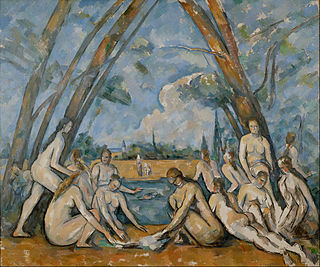 W
WThe Bathers is an oil painting by French artist Paul Cézanne first exhibited in 1906. The painting, which is exhibited in the Philadelphia Museum of Art, is the largest of a series of Bather paintings by Cézanne; the others are in the Museum of Modern Art in New York City, National Gallery, London, the Barnes Foundation, Pennsylvania, and the Art Institute of Chicago. Occasionally referred to as the Big Bathers or Large Bathers to distinguish it from the smaller works, the painting is considered one of the masterpieces of modern art, and is often considered Cézanne's finest work.
 W
WThe Card Players is a series of oil paintings by the French Post-Impressionist artist Paul Cézanne. Painted during Cézanne's final period in the early 1890s, there are five paintings in the series. The versions vary in size, the number of players, and the setting in which the game takes place. Cézanne also completed numerous drawings and studies in preparation for The Card Players series.
 W
WL'Estaque, Melting Snow is a c. 1871 oil-on-canvas painting by French Post-Impressionist artist Paul Cézanne. It shows a view from the outskirts of L'Estaque, a small village near Marseille, with a steep hillside covered in a drift of melting snow underneath a foreboding dark grey sky. Filled with intense emotion, the painting has been described as similar to the work of Vincent van Gogh the following decade, and a painting more formally similar to early 20th-century than contemporaneous art. L'Estaque, Melting Snow was painted in a single session. It is one of only two snow-laden winter subjects Cézanne painted.
 W
WForest is a painting by French painter Paul Cézanne. An oil on canvas, it represents a wooded area close to Aix-en-Provence. It is currently in the collection of the National Gallery of Canada.
 W
WThe Hanged Man's House is an 1873 oil on canvas painting by Paul Cézanne. The painting is exhibited at the Musée d'Orsay in Paris.
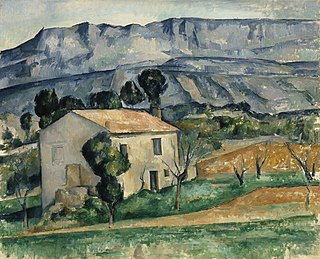 W
WHouse in Provence is an oil painting by French artist Paul Cézanne. Created between 1886 and 1890, it is currently part of the permanent collection in the Indianapolis Museum of Art.
 W
WMont Sainte-Victoire is a 1904–1906 series of oil paintings by French artist Paul Cézanne.
 W
WMont Sainte-Victoire and the Viaduct of the Arc River Valley is an oil painting on canvas completed by the French artist Paul Cézanne between 1882 and 1885. It depicts Montagne Sainte-Victoire and the valley of the Arc River, with Cézanne's hometown of Aix-en-Provence in the background. Once owned by the art collectors and patrons Henry and Louisine Havemeyer, the painting was bequeathed to the Metropolitan Museum of Art in New York after the latter's death in 1929.
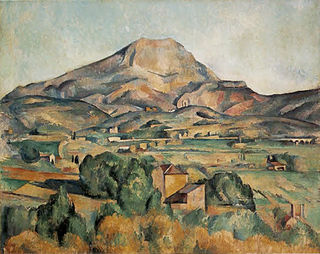 W
WMont Sainte-Victoire seen from Bellevue is a landscape painting dating from around 1886, by the French artist Paul Cézanne. The subject of the painting is the Montagne Sainte-Victoire in Provence in southern France. Cézanne spent a lot of time in Aix-en-Provence at the time, and developed a special relationship with the landscape. This particular mountain, that stood out in the surrounding landscape, he could see from his house, and he painted it in on numerous occasions.
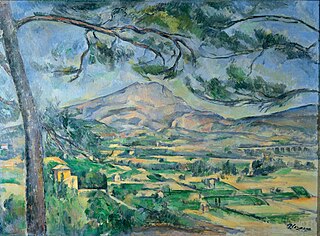 W
WMont Sainte-Victoire with Large Pine is an oil on canvas painting by the French artist Paul Cézanne. It is owned by the Courtauld Institute of Art and on display in the Gallery at Somerset House. It belongs to a series of oil paintings of Mont Sainte-Victoire that Cézanne painted throughout his career.
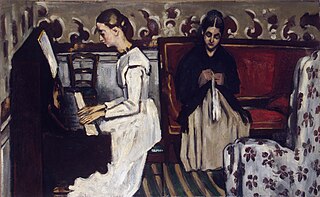 W
WThe Overture to Tannhäuser is an 1869 oil on canvas painting by Paul Cézanne, now in the Hermitage Museum. It comes from the Moscow collection of Ivan Morozov. The painting shows Cézanne's sisters at their home near Aix-en-Provence. Its title refers to the work played by the pianist on the left, the overture to the Wagner opera Tannhäuser.
 W
WPortrait of Ambroise Vollard is an 1899 oil on canvas portrait by Paul Cézanne of his art dealer Ambroise Vollard. It was bequeathed by Vollard on his death to the Petit Palais in Paris, where it is still housed today. Like many of his portraits, the Portrait of Ambroise Vollard displays the significant role of the subject in Cézanne’s life, and specifically, the artist’s gratitude for promoting his work and establishing his reputation as an artist.
 W
WPyramid of Skulls is a c. 1901 oil painting by French Post-Impressionist artist Paul Cézanne. It depicts four human skulls stacked in a pyramidal configuration. Painted in a pale light against a dark background, Pyramid of Skulls is exceptional in the artist's oeuvre, for "in no other painting did Cézanne place his objects so close to the viewer." For art historian Françoise Cachin, "these bony visages all but assault the viewer, displaying an assertiveness very much at odds with the usual reserve of domestic still-life tableaux."
 W
WRideau, Cruchon et Compotier is a painting created circa 1893 to 1894 by French artist Paul Cézanne. It is considered the most expensive still life ever sold at an auction.
 W
WSeated Peasant is a late 19th-century painting by Paul Cézanne. Done in oil on canvas, the work depicts a seated peasant, likely a worker at Jas de Bouffan, Cézanne's family estate in Aix-en-Provence. The painting's age is unknown but credibly dated between 1892 and 1896. It is currently in the collection of the Metropolitan Museum of Art.
 W
WStill Life with Teapot is a still-life oil painting dating between 1902 and 1906, by the French artist Paul Cézanne. The subject of the painting is a table draped loosely with a patterned cloth on which lie fruit, crockery and a knife. The painting was acquired by the National Museum Wales in 1952 and is on display at the National Museum Cardiff.
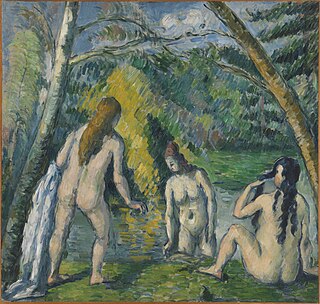 W
WThree Bathers is an 1879-1882 oil on canvas painting by Paul Cézanne, which is housed in the Petit Palais in Paris. It shows three bathing female nudes framed in an arch formed by two trees. Executed in a typically Impressionist style with short heavy brushstrokes and strong colours, the painting displays notable pictorial composition and form.
 W
WView of Auvers-sur-Oise is the common English name for a Paul Cézanne painting known by various French names, usually Paysage d'Auvers-sur-Oise, or in the artist's catalogue raisonné, Groupe de maisons, paysage d'île de France. It is believed to have been painted in 1879–80, several years after Cézanne's residence in Auvers-sur-Oise, a small village northwest of Paris. The painting depicts a landscape of Northern France; the exact location has not been determined.
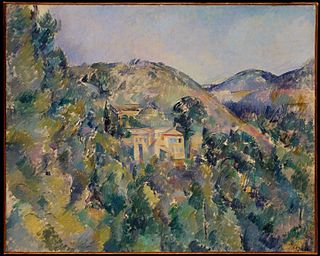 W
WView of the Domaine Saint-Joseph is a painting by French artist Paul Cézanne. Another name given to the work is La Colline des pauvres.
 W
WWomen Bathing or Bathers is a c.1900 oil on canvas painting by Paul Cézanne, now in the Ny Carlsberg Glyptotek in Copenhagen. Individual or grouped male or female bathers were a major theme in his work from the 1870s onwards, most notably his so-called Big Bathers.